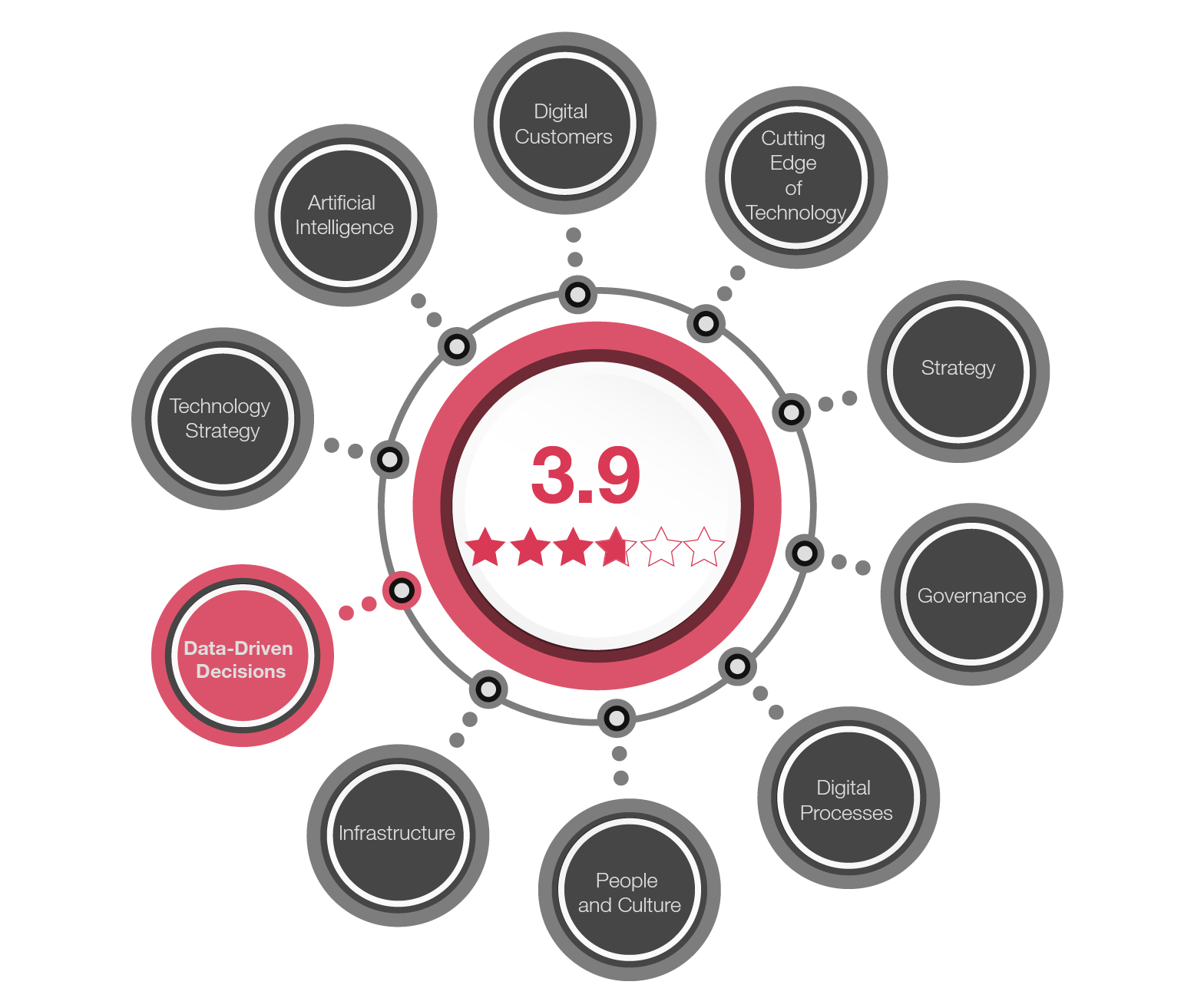
Brazil Digital Transformation Index 2023
An overview of how organizations are maturing to embrace digital technologies and create valuable competitive advantages for their businesses
Our exclusive methodology for measuring digital transformation progress in companies
In Brazil, organizations did not have a systematized approach to measure their digital transformation maturity. With this study, we present an exclusive and unprecedented methodology to consolidate the various aspects of digital transformation, the Brazil Digital Transformation Index (ITDBr).
The study by PwC Brazil and the Fundação Dom Cabral (FDC) is to measure the digital maturity level of companies across ten dimensions. The average ITDBr of participating companies was 3.3, above the scale’s midpoint, which ranges from 1 to 6.


Digital dimensions

Strategy
An effective digital strategy begins with a precise mapping of opportunities and a future vision for both the company and the digital business. This includes creating an initial 100-day plan and a short-, medium-, and long-term strategy, identifying the necessary technologies to realize this digital future vision.
Items with the best and worst evaluations in each dimension
5
Importance of the digital transformation strategy in the organization
3.3
Plan of established goals and adoption of agile methods for the execution of the digital transformation strategy

Governance
The success of digital transformation can be achieved by implementing solid governance and management mechanisms. This structure involves creating forums and committees, defining tracking metrics, and initiatives focused on people management, change management, and partnerships.
Items with the best and worst evaluations in each dimension
3.2
Incentive for open innovation initiatives focused on digital transformation
2.7
Constant assessment of the maturity level for digital transformation

Digital Processes
The rationale for digital transformation lies in the ability to forge businesses and generate additional revenue based on digital products and services. To achieve this, it’s essential to generate value on two fronts: internally, through the digitalization of business areas and operations and improving efficiency indicators, and externally, by attracting new customers and partners. The organization must develop internal and external processes and solutions to ensure this success.
Items with the best and worst evaluations in each dimension
3.9
Practices for adopting new digital channels for current customers
3.4
Practices for developing entirely new digital business models

People and Culture
Promoting a culture oriented towards digital transformation should be a priority. This involves developing leaders capable of connecting business and technology, besides creating an online training platform to disseminate knowledge across all organizational levels. The organizational structure should be agile, encouraging experimentation and facilitating collaboration between different industries.
Items with the best and worst evaluations in each dimension
3.8
Perception of leadership as an influencer for the organization’s digital transformation
3.2
People management policies and organizational values encompass digital transformation

Infrastructure
A solid infrastructure represents the technological foundation of the organization. It integrates essential digital assets for using analytics and artificial intelligence (AI). It involves investing in technologies such as cloud computing and automating and designing digital processes for the organization’s information flow. The goal is continuously improving and innovating, creating value for the customer journey.
Items with the best and worst evaluations in each dimension
4.2
Teams dedicated to technological infrastructure projects and data engineering
3.1
Teams dedicated to designing the customer journey and adequate understanding of user experience and interface

Data-Driven Decisions
Organizational approach in which decisions are made based on data and analysis rather than intuitions, perceptions, or personal experiences. An organization with a data-driven culture values and utilizes information and metrics to guide strategies, operations, and performance evaluations.
Items with the best and worst evaluations in each dimension
4.7
Concern about data, compliance with the LGPD (General Data Protection Law), and mitigation of risks related to digital transformation
3.4
Sense of urgency for the development and hiring of new digital competencies

Technology Strategy
The technology strategy should define the priorities for the company’s technological architecture, establishing priorities that support the business strategy and aim to support incremental or disruptive movements.
Items with the best and worst evaluations in each dimension
3.7
Development of strategic alliances to drive digital transformation
3.6
Perception of developing a strategy focused on new technologies and digital business models

Artificial Intelligence
Integrating artificial intelligence into various processes, systems, products, and services can significantly enhance the operational and strategic efficiency of the organization.
Items with the best and worst evaluations in each dimension
2.7
Use of AI in strategic projects
2.0
Emphasis on a training program for hardware with a focus on AI projects

Digital Customers
Collecting and analyzing customer data from different channels, such as social media, is essential to develop tailored strategies to enhance the customer experience.
Items with the best and worst evaluations in each dimension
3.8
Capturing and processing of customer data in business environments
2.4
Existence of gamification projects for capturing and processing customer data

Cutting Edge of Technology
Exploring innovations at the cutting edge of technology, including in areas like nanotechnology, blockchain, 3D, robotics, and cloud computing, can revolutionize entire sectors and drive significant advancements, pushing beyond the current boundaries of knowledge.
Items with the best and worst evaluations in each dimension
3.7
Ongoing projects for the use of digital contracts
1.7
Ongoing projects for the use of Metaverse technology

“When we began working on the index methodology, it became clear that many organizations still needed to clarify what digital transformation was. Some saw it merely as technology products, which confirms the importance of broadening this discussion in the market. With the ITDBr, we can help organizations understand where they are positioned in this transformation journey and what they need to do to advance.”

Survey demographics
How companies are classified

Annual revenue
Almost half of the study respondents have an annual revenue of over BRL 1 billion.
Large companies more comprehensively incorporate the digital transformation agenda into their daily operations. In contrast, smaller ones tend to adopt specific actions and solutions. Large companies tend to integrate digital transformation more holistically into their everyday operations. In contrast, smaller companies often focus on implementing specific, targeted actions and solutions. Regardless of size, all show significant room for improvement in their digitization journey.
- 57% of companies with revenues below BRL 300 million are selective, with close results among optimizers (23%) and visionaries (20%).
- Among those with revenues above BRL 1 billion, selective companies also predominate (53%). However, optimizers gain ground (32%) , and visionaries remain in the smallest group (13%).
Respondents’ job titles
Respondents in the executive management of the participating companies make up 58% of our sample. Another 6% are on the board of directors.
“Many organizations have narrowly associated their digital transformation agenda with only the advancements in modern technology. However, it’s imperative to have a comprehensive understanding of the underlying business challenges, investment readiness, team competencies, and the attributes of the chief digital officer. More fundamentally, it’s about establishing a systematic approach to develop digital processes that are in harmony with executive leadership, customer needs, and the evolving capabilities of the workforce. The formulation of this index by the FDC and PwC aims to provide a nuanced perspective to the Brazilian market, clarifying the true essence of digital transformation beyond the typical market hype.”


More results by industry segment
The Financial Services segment is the most advanced in digital transformation, with scores above 4 in seven of the ten dimensions analyzed. Following that, the IT sector scored above 4 in five out of the ten dimensions. Still, it showed weak performance in the technological frontier aspect – the exploration of innovations in areas with transformative potential. The Energy segment achieved the highest score among all sectors in a specific dimension: 5.1 for technology strategy.


General overview of digital transformation in Brazil
Internal and external factors affecting the digital transformation journey of companies in Brazil.
Understanding digital transformation
For two-thirds of the respondents, a strategic vision is the term that best summarizes their understanding of digital transformation in organizations. The result shows that the digitalization process goes beyond the operational and short-term level.
Challenges confronting organizations
Organizational culture emerges as the primary barrier hindering the advancement of the digital transformation agenda. The survey responses also reflect a notable lack of urgency in cultivating and recruiting digital skills. Additionally, the environment for experimentation and agility is poorly rated.

Challenges and essential steps to propel the digital agenda
What are the key issues to address?
Operational efficiency is the most anticipated outcome
Organizations are still more focused on the immediate or short-term impacts of digitalization and less on strategic and cultural transformation, processes that are more time-consuming but crucial for competitiveness and the sustainability of the business.

The journey to digital transformation
Main transformations in the last five years
Backoffice is the main target of digital transformation in companies. Many highlighted adopting digital processes and automation (93%) and configuring applications and systems (61%). These changes include the incorporation of RPAs, ERPs, digital tools, and system integration.

“The low understanding of how digital technology can enable personalized experiences can lead to transformations that do not fully meet customer needs, thereby failing to capture opportunities offered by new forms of interaction, new channels, and innovative technologies. Precise alignment between digital technologies and new customer priorities and behaviors is essential to create personalized experiences at scale, strengthen customer-brand relationships, and capture new business value.”
Automation and the implementation of digital channels are areas that receive more attention from organizations
“Even though the adoption of digital technologies, such as artificial intelligence, and the creation of new products and services are important aspects of digital transformation, leaders must ensure that all initiatives are connected to the company’s strategy and have proper governance for their execution. Otherwise, these efforts become isolated projects, do not yield the expected results, and lose prominence in executives’ agendas.”


Focus points
While companies recognize the importance of a digital transformation strategy, they still do not prioritize the complete business transformation into a fully digital model. Only 7% of respondents have indicated comprehensive changes in their strategy, including redesigning the business core and a phased implementation across all areas.
Digital governance maturity is low in organizations: only 1% of respondents mentioned concrete initiatives for implementing digital governance. Additionally, few companies incorporate risk management practices (1%) or conduct regular maturity assessments concerning digital transformation.
Cybersecurity also does not occupy a prominent position in this scenario: only 3% of respondents reported robust initiatives, such as predictive fraud analysis and data security reinforcement. Although there is a concern regarding compliance with the General Data Protection Law (LGPD), the lack of robust risk management and cybersecurity practices undermines personal data protection.
Contact us







